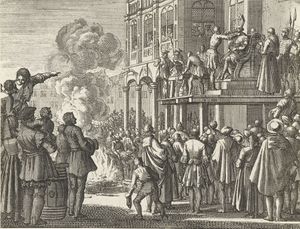Jacob van Campen (1505-1535)

Engraving by Jan Luiken in C. Commelin, Beschryvinge van Amsterdam, Amsterdam 1693.
Source: Rijksmuseum.
Jacob van Campen (Kampen), or Jacob Jansz van IJsselmuiden, also called Coomans, born 1505, a bishop of the Dutch Anabaptists and a martyr, executed at Amsterdam on 10 July 1535. He was a native of IJsselmuiden, was a cloth shearer by trade, but sometimes he worked as a peddler. He was married to Aeff Petersdochter of North Holland. It is rather strange that this important leader is not found in the martyr books. The reason for the omission may be that in his early period he had many contacts with revolutionary leaders.
Jacob van Campen was one of the 12 apostles sent out by Jan Matthijsz van Haarlem in the fall of 1533. His trips extended unto Münster in Westphalia and Emden in East Friesland; he also visited the Dutch provinces of Groningen and Friesland; his activity in the towns of Kampen and Rotterdam is known and in the provinces of North Holland and Utrecht he baptized a number of persons. He himself was baptized and ordained a bishop by Pieter de Houtzager. From early 1534 he mostly stayed at Amsterdam, then already the seat of a considerable Anabaptist congregation. In February 1534 Jacob van Campen and Pieter de Houtzager baptized a large number of persons at Amsterdam and van Campen held regular meetings there near the Jan Rodenpoorts tower. The assertion made by some authors, e.g., L. Hortensius and G. Brandt, that Jacob van Campen was sent from Münster by Jan van Leyden to be a bishop at Amsterdam is not correct. He warned against the revolutionary Münsterite principles, especially against polygamy, and opposed acts of violence and revolt. In a meeting of Dutch Anabaptist leaders held at Spaarndam near Haarlem in December 1534 or January 1535, where the question was discussed whether the Anabaptists of Holland should take up arms and go to Münster, van Campen argued that the coming of the Lord should be patiently awaited; when Jan van Geelen planned an attack on the city of Amsterdam (May 1535), Jacob van Campen "did not consent to this proposal." The accusation of some authors like Vos and Mellink that van Campen belonged to the revolutionary wing of Anabaptism is not true. He was a follower of Melchior Hoffman and a man of peaceful principles.
As to his interpretation of the Bible van Campen was of the opinion (like Cornelis Pietersz wt den Briel, while Obbe Philipsz was opposed to this view) that the Scriptures "stand on two hoofs" (see Gespauwde Klauw), i.e., he defended the doctrine that "all that is written in the Old Testament is also found in the New Testament and will take place either spiritually or literally." This opinion gave rise to much unsound interpretation of Old Testament prophecies.
Jacob van Campen was an important leader, whose activity was well known to the government. As early as 23 February 1534, a mandate of the imperial stadholder of Friesland indicated van Campen as a principal Anabaptist, together with Melchior Hoffman, Obbe Philipsz, and Pieter de Houtzager, and on 2 March 1534, it was announced in Amsterdam that anyone who delivered Jacob van Campen or Jan Matthysz to the officials of justice would be rewarded. In May 1535 van Campen was arrested in Amsterdam. A widow who had given him shelter was hanged with her son before her own door. Van Campen was tried several times and also tortured. He did not forsake his faith. On 10 July he was sentenced to death and executed that very day. First his tongue "by which he has disseminated his false teachings" was cut off, then his right hand "by which he has rebaptized." Thereupon he was beheaded and his corpse burned.
His confession during the trials, containing a number of valuable facts about the Anabaptist movement in Amsterdam, was published by Grosheide.
Bibliography
Doopsgezinde Bijdragen (1917): 85, 98, 101 f.
Hoop Scheffer, Jacob Gijsbert de. Inventaris der Archiefstukken berustende bij de Vereenigde Doopsgezinde Gemeente to Amsterdam, 2 vols. Amsterdam: Uitgegeven en ten geschenke aangeboden door den Kerkeraad dier Gemeente, 1883-1884: I, No. 97.
Kühler, Wilhelmus Johannes. Geschiedenis der Nederlandsche Doopsgezinden in de Zestiende Eeuw. Haarlem: H.D. Tjeenk Willink, 1932: See Index.
Mellink, Albert F. De Wederdopers in de noordelijke Nederlanden 1531-1544. Groningen: J.B. Wolters, 1954: See Index.
"Verhooren en Vonissen der Wederdoopers, betrokken bij de aanslagen op Amsterdam in 1534 en 1535", in Bijdragen en Mededeelingen van het Historisch Genootschap 41 (Amsterdam, 1920): 94-105, 193. Available in full electronic text at http://www.dbnl.org/tekst/_bij005192001_01/_bij005192001_01_0005.php.
| Author(s) | Nanne van der Zijpp |
|---|---|
| Date Published | 1957 |
Cite This Article
MLA style
Zijpp, Nanne van der. "Jacob van Campen (1505-1535)." Global Anabaptist Mennonite Encyclopedia Online. 1957. Web. 11 Jan 2025. https://gameo.org/index.php?title=Jacob_van_Campen_(1505-1535)&oldid=147904.
APA style
Zijpp, Nanne van der. (1957). Jacob van Campen (1505-1535). Global Anabaptist Mennonite Encyclopedia Online. Retrieved 11 January 2025, from https://gameo.org/index.php?title=Jacob_van_Campen_(1505-1535)&oldid=147904.
Adapted by permission of Herald Press, Harrisonburg, Virginia, from Mennonite Encyclopedia, Vol. 3, pp. 59-60. All rights reserved.
©1996-2025 by the Global Anabaptist Mennonite Encyclopedia Online. All rights reserved.
